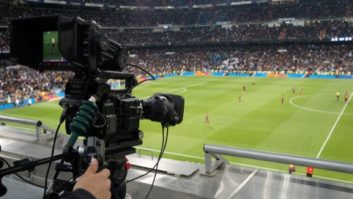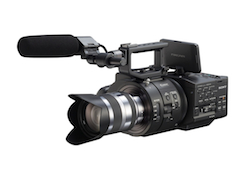
The Olympics is often a technology milestone for broadcasting. In 1948, the BBC did the first ever live outside broadcast to homes from Games that were held where its White City buildings are now. At the Mexico Olympics of 1968 the innovation was colour. In 1984, the Los Angeles Olympics were the first to be captured in HD (by NHK), even though only four people in the truck could see it.
Now, the 2012 Olympics will see the introduction of Ultra HD, or Super Hi-Vision, with all of the world’s SHV cameras in London, and public viewing in six UK, Japanese and US cities, thanks to a collaboration between NHK, the BBC, and Olympic Broadcast Services.
Audiences will be able to watch SHV images of the Games at three locations in the UK (the BBC Radio Theatre at Broadcasting House in London, its Glasgow studios at Pacific Quay, and the National Media Museum in Bradford), as well as four NHK sites in Tokyo and Osaka, and at an NBC venue in Washington DC. A prototype SHV plasma screen is also likely to be on show at the International Broadcast Centre in London — broadcasters will also be able to watch highlights on the NHK stand at IBC, probably on a Sharp 85-inch screen.
“We will be running screenings all day at these venues. People can book tickets free at the BBC website to watch an hour-long highlights package, with events from the main stadium, the velodrome, the aquatics centre and the basketball arena,” says Tim Plyming (pictured), the BBC’s project lead for the Super Hi-Vision project.
It will mainly show locked-off shots, “where your eye can do the editing […] to give people the experience of being there.” The production will use three SHV cameras to cover the opening and closing ceremonies plus the Men’s 100m Final live, as well as creating highlights packages of other events.
Higher frame rate
NHK is also bringing its new, prototype compact camera (about the same size as a conventional ENG camera), but isn’t currently planning to use it for the Games coverage. However, if everything is working perfectly it might be used.
Besides weighing a lot less (about 5kg) and being more compact, the new camera can also shoot at 120 frames per second, so could be used for slow-motion work, recording on to 16 solid-state cards. The new 33-megapixel (7680×4320 pixel) CMOS sensor uses an advanced two-stage (4-bit then 8-bit) cyclic analogue-to-digital converter to deliver a 12-bit image at the higher frame rate (twice that of the current SHV cameras).
This architecture also reduces power consumption, with the ADC drawing 800mW (out of a total drive power of 2.5W). To deal with the high number of pixels involved, the sensor outputs alternating rows of pixels to ADCs on either side, each of which has 48 parallel outputs. The 120fps sensor will reduce motion blur and allow for much better slo-mo replay.
As resolution increases (and 8K is 16 times the resolution of HD) motion defects become much more noticeable, so being able to offer higher frame rates is more important for Ultra HD than normal HD. The current cameras use four 1.25-inch eight megapixel CMOS sensors (two for green and one each for red and blue) and weigh about 20kg.
All the SHV coverage will be done at 60Hz, and will be projected on screens of up to 400-inches diagonal (10m).
The production team will also be doing some shooting around London before the Games begin, to capture the Olympic city, which will be one of the shows on offer when screenings begin on 23 July. The other will be a tour of the Olympic park. The Games begin on 28 July.
Camera switching
The BBC and NHK, who have been working on the project for two-and-a-half years, are building what is effectively the first Ultra HD station for the Games at Television Centre in west London, with a complete channel operation, “creating a highlights channel as well as delivering live feeds,” says Plyming.
The signals will be sent from the NHK OB van at the venues to Television Centre using an 80Gb dual-diversity dark fibre link. Recording will be onto Panasonic solid-state storage racks at TVC, using 32 64GB P2-based cards to provide two hours of recording. The OB van will only be able to do straight forward switching between the cameras, as realtime effects aren’t yet practical for 8K video.
“The thing that I’m having to train my team to do is to stay with the shots much longer, because there is so much to see,” says Plyming. “We need to allow people to take it all in. However, staying with the shot longer makes it quite different from the television experience.”
To create the 22.2 Surround Sound, the project will have access to the hundreds of microphone points in the stadium, and will also have some football-sized globe microphones (housing 22 mics), positioned close to the cameras, which have been given very good positions at each venue.
To transmit the pictures, the project will make use of academic and private IP networks and satellite links. In the UK, JANET (the Joint Academic NETwork) has a 20Gb backbone, but the signals will be compressed in to two MPEG transport streams, so that they should require no more than a gigabit per second.
NHK believes that portable and remote point-of-view cameras, compact recorders, and card-based edit systems will become available for SHV over the next five years, with expanded post production systems, master monitors, and a 22.2-channel Surround Sound production system emerging within the following five years. It expects Ultra HD production equipment to reach the same level as HD is now by about 2017, and hopes to offer a satellite to home service in the 21GHz band by about 2020.
By David Fox






